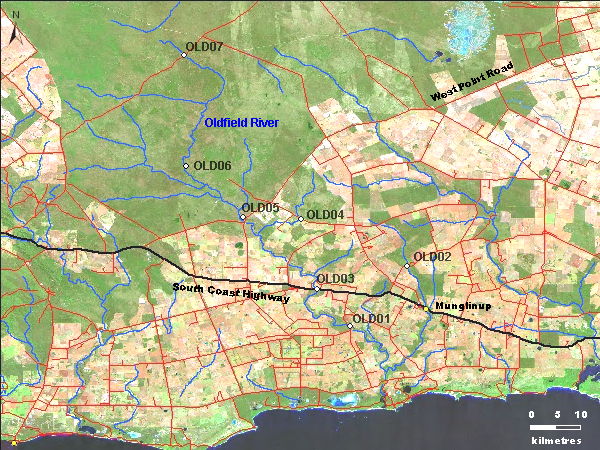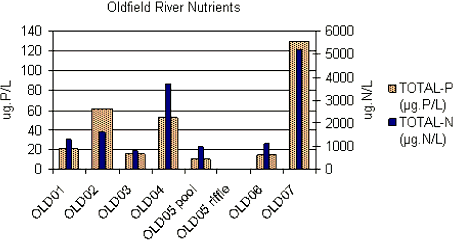

Seven sites were sampled on the Oldfield River system and are shown on the map above. Photographs are available for each site:
| OLD01 | OLD02 | OLD03 | OLD04 | OLD05 | OLD06 | OLD07 |
Two types of Amphipoda were found in the river that are of particular interest as they are new species that have not been described.
Pictures of these can be seen in the gallery.
Sites OLD07 - OLD05 were considered pristine with the river embankments and floodway entirely vegetated with native plant species and no evidence of human or livestock damage. Sites OLD004 and OLD03 were slightly disturbed with some areas of human disturbance and weeds. The two lowest sites OLD02 and OLD01 were considered degraded and weed infested with greater weed infestation at the lowest site.
While the river is naturally saline, the salinity varied greatly along its length. The upmost pool (OLD07) was the saltiest with 87.2 ppt (parts per thousand) which is over twice as salty as seawater (35 ppt) and hypersaline, this pool was small where evaporation would be significant. The lowest salinity was recorded in OLD04 with only 2 ppt which was muddy fresh water in Cheadanup Creek. OLD06 had considerably lower salinity (9.7 ppt) then the pools both upstream and downstream. This may be due in part to the large size of the pool and as such lower evaporation rates.
Nutrients samples indicated that high nitrogen levels were recorded at sites OLD01, 02, 04 and 07. Phosphorus levels were generally lower with the exception of sites OLD02 and 07. The upmost site OLD07 had the highest phosphorus and nitrogen levels for the river which is surprising given its situation in pristine wilderness. One possible explanation is the contribution of nutrients following the severe fires around the site in 2003 which would have resulted in large amounts of ash and sediment being washed into the pool bringing nutrients.
High chlorophyll levels were recorded in the lower sites, particularly OLD02 which had quite high nutrient levels. The chlorophyll indicate high levels of microcellular phytoplankton growth.

